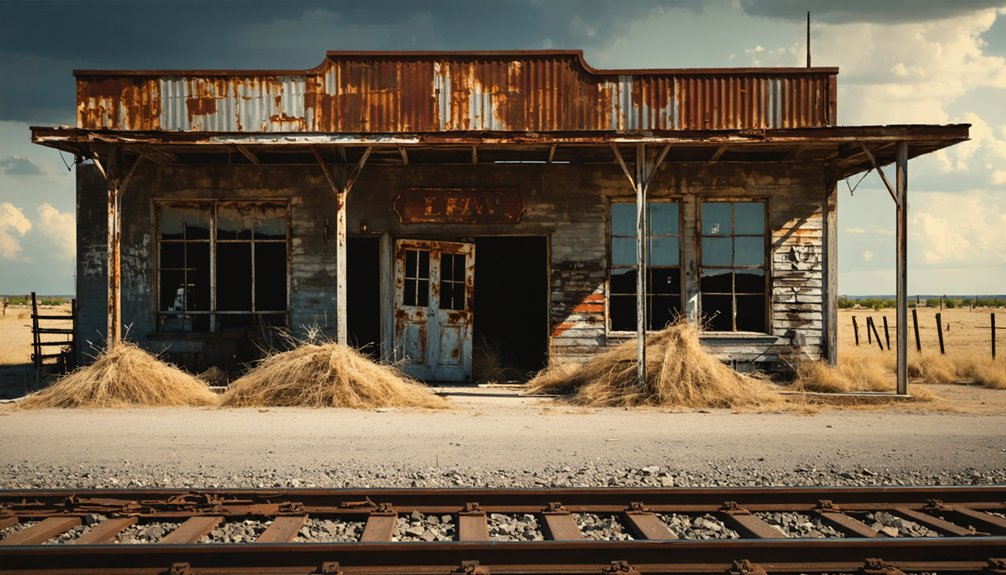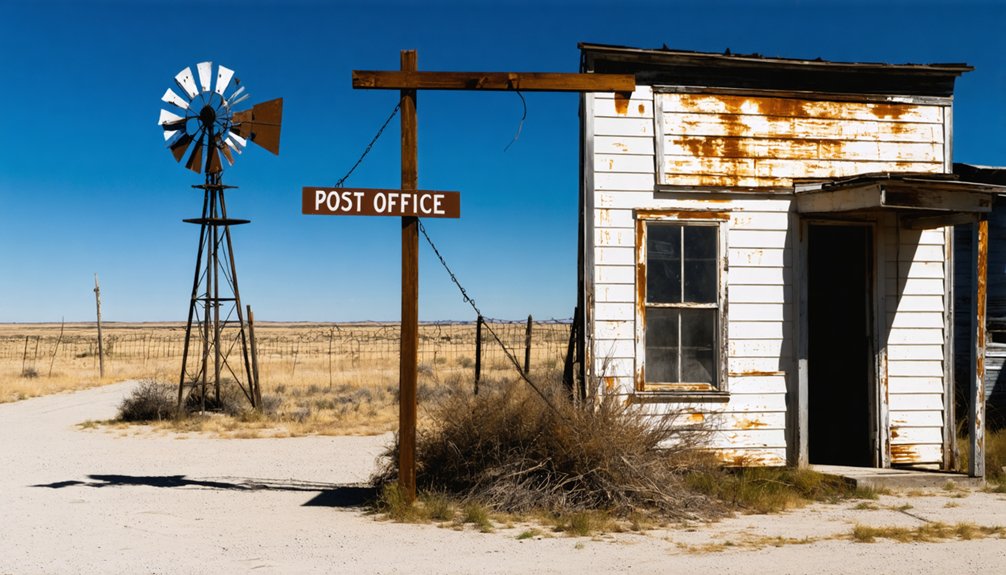You’ll find Rock Island’s remains along the Brazos River, where settlers established a frontier outpost in the 1890s. Originally home to a plantation, general store, and ferry crossing, the town was renamed Glenrio in 1908 and flourished as a Route 66 destination. The settlement’s unique position between jurisdictions shaped its development until Interstate 40’s arrival led to its decline. Today, preserved landmarks tell stories of Texas frontier life and Route 66’s golden age.
Key Takeaways
- Rock Island originated as a Texas frontier settlement in the 1890s, featuring a general store, inn, cotton gin, and blacksmith shop.
- The town was renamed Glenrio in 1908 and became a significant stop along Route 66 during the early 20th century.
- Visitors can explore preserved landmarks including frontier-era homes and possible foundations of early commercial structures.
- The town’s decline began when Interstate 40 bypassed it, transforming it into a ghost town.
- Rock Island operated a post office from 1849 to 1857 and was historically significant for its position between state jurisdictions.
The Birth of a Border Town
When settlers first arrived in Rock Island, Texas in the 1890s, they were drawn by promises of a tropical paradise near the Gulf of Mexico. The border town origins trace back to a pre-Texas Republic plantation, named for a small island in the Brazos River.
Dreams of a Gulf Coast paradise lured settlers to Rock Island, Texas – a plantation town born from an island in the Brazos.
You’ll find conflicting accounts of its exact location – some place it east in Waller County, while others insist it was west in Washington County, due to the river’s changing path over time. Today, urban explorers document the remnants of this once-thriving settlement.
The early settlers quickly established the foundations of a thriving community. By 1837, you’d have found a bustling general store, inn, cotton gin, and blacksmith shop. Much like the historic Battle of Rock Island Rapids, disputes over river access and navigation rights shaped the development of many frontier settlements along waterways.
A ferry crossing on the Brazos River enhanced transportation options, while the town’s strategic position near major travel routes and the Texas-New Mexico state line secured its importance as a border settlement.
Life Between Two States
While Rock Island’s unique position between two jurisdictions shaped its development, the town’s daily life revolved around key transportation corridors that connected communities across county and state lines. The Brazos River ferry crossing became essential for economic interactions, linking plantations, merchants, and travelers between Washington and Waller counties. Today, Rock Island sits within Colorado County, Texas, marking a significant change from its historical location.
- You’d find the bustling Rock Island Academy, general store, and blacksmith shop serving residents from both sides of the border.
- The post office (1849-1857) handled communications flowing between jurisdictions.
- Cultural exchanges flourished around the inn, where travelers and locals mingled.
- The cotton gin processed harvests from surrounding plantations, creating a shared economic base.
When railroads bypassed the river crossing, shifting east toward Hempstead, Rock Island’s strategic position diminished, ultimately affecting its sustainability.
From Boom to Bust: The Route 66 Years
After the Rock Island and Pacific Railroad renamed the town to Glenrio in 1908, this border settlement transformed from a modest railroad stop into a vibrant Route 66 destination.
You’d have found a bustling travel culture by 1926, when the Mother Road brought streams of motorists through town. The unique state-line position created interesting economic shifts – you couldn’t buy alcohol on the Texas side or gas on the New Mexico side due to different state laws and taxes.
Today, visitors can still see the State Line Sign where they can stand in two states at once. The town had already been attracting motorists since the construction of the Ozark Trail in 1917.
Glenrio’s prosperity peaked mid-century with its motels, diners, and filling stations catering to cross-country travelers.
But when Interstate 40 emerged, bypassing the town entirely, Glenrio’s fate was sealed. What was once a thriving Route 66 hub gradually faded into a ghost town, its vintage buildings standing as silent witnesses to a bygone era.
Preserved in Time: Notable Landmarks
Unlike its better-documented neighbor Glenrio, Rock Island’s preserved landmarks paint a more modest picture of Texas frontier life. Much like the Chicago railway that transformed Glenrio in 1906, Rock Island’s development was tied to transportation infrastructure. The town’s early small farmers helped establish its agricultural identity when they settled on 150-acre plots.
You’ll find traces of historic architecture in the remaining residential buildings that showcase late 19th-century Texas design. While the railway’s influence shaped the town’s identity, only subtle remnants hint at its transportation history.
- Original homes featuring authentic frontier-era construction methods and materials
- Creek-side setting that gave the settlement its first name, Crasco
- Possible foundations of early commercial structures waiting to be rediscovered
- Historic roadbeds and railway traces that tell the story of changing transportation routes
The natural landscape serves as a backdrop, preserving Rock Island’s rural character and creating an atmosphere where you can still experience authentic Texas ghost town ambiance.
Legacy and Cultural Impact

Despite its name recognition, Rock Island’s legacy presents a complex historical narrative that differs from typical ghost town stories.
You’ll find that unlike many abandoned settlements, Rock Island isn’t considered a true ghost town by locals. Its historical significance stems from its origins as a plantation near the Brazos River, where it operated a post office from 1849 to 1857. The area was renamed Glenrio by railroad officials in the early 1900s, marking a significant transition in its identity. The town gained additional prominence when it became part of the Ozark Trail network, which later transformed into the iconic Route 66.
The community’s decline followed a familiar pattern when the railroad bypassed it, building east of the Brazos. While the original settlement faded, its story reflects broader themes in Texas’s development, from agricultural roots to transportation changes.
Today, Rock Island’s legacy lives on through educational opportunities and preservation efforts, serving as a valuable reminder of how external forces can reshape communities and local economies.
Frequently Asked Questions
Can Tourists Legally Explore Abandoned Buildings in Glenrio Today?
You can’t legally explore Glenrio’s abandoned buildings since they’re on private property. For your safety and to avoid trespassing charges, you’ll need explicit permission from property owners before exploring.
What Happened to the Original Residents’ Property Deeds and Titles?
Despite 100+ years passing, you’ll find these property deeds safely preserved in county clerk offices, where they’re maintained to prevent property disputes and support historical preservation efforts, regardless of abandonment status.
Are There Any Regular Maintenance Efforts to Preserve Remaining Structures?
You won’t find any regular maintenance or preservation efforts at the remaining structures. Despite their historical significance, they’re steadily deteriorating without organized intervention from local groups or heritage organizations.
Do Any Descendants of Original Glenrio Families Still Claim Ownership?
While many assume all family connections are lost, you’ll find Roxanne Brownlee, daughter of Joseph Brownlee, maintains one of the few historical claims as a resident descendant from Glenrio’s original families.
What Wildlife Species Now Inhabit the Abandoned Buildings and Surrounding Area?
You’ll find Mexican long-nosed bats roosting in the ruins, while coyotes den nearby. During urban exploration, watch for barn owls, kestrels, various snakes, and lizards inhabiting the crumbling structures.
References
- https://digging-history.com/2014/03/12/off-the-map-ghost-towns-of-the-mother-road-glenrio-texas-and-new-mexico/
- https://www.youtube.com/watch?v=LiS5UTVrzlQ
- https://www.legendsofamerica.com/tx-glenrio/
- https://www.route66roadtrip.com/route-66-glenrio-texas.htm
- https://en.wikipedia.org/wiki/Rock_Island
- https://thebullamarillo.com/the-life-and-times-of-glenrio-tx/
- https://www.desertedtexas.org/2015/05/rock-island-texas/
- https://www.tshaonline.org/handbook/entries/rock-island-tx-colorado-county
- https://www.texasescapes.com/CentralTexasTownsSouth/Rock-Island-Texas.htm
- https://www.nps.gov/places/glenrio-historic-district.htm



